The Intel Core i9-9900K at 95W: Fixing The Power for SFF
by Ian Cutress on November 29, 2018 8:00 AM ESTCPU Performance: Office Tests
The Office test suite is designed to focus around more industry standard tests that focus on office workflows, system meetings, some synthetics, but we also bundle compiler performance in with this section. For users that have to evaluate hardware in general, these are usually the benchmarks that most consider.
All of our benchmark results can also be found in our benchmark engine, Bench.
PCMark 10: Industry Standard System Profiler
Futuremark, now known as UL, has developed benchmarks that have become industry standards for around two decades. The latest complete system test suite is PCMark 10, upgrading over PCMark 8 with updated tests and more OpenCL invested into use cases such as video streaming.
PCMark splits its scores into about 14 different areas, including application startup, web, spreadsheets, photo editing, rendering, video conferencing, and physics. We post all of these numbers in our benchmark database, Bench, however the key metric for the review is the overall score.
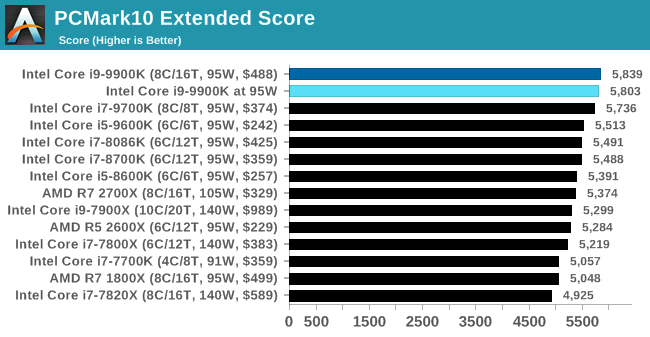
PCMark10 is more forgiving, as it has lots of pauses and only a few full-on power tests, emphasising single core speed. There isn't much lost when in 95W mode here.
Chromium Compile: Windows VC++ Compile of Chrome 56
A large number of AnandTech readers are software engineers, looking at how the hardware they use performs. While compiling a Linux kernel is ‘standard’ for the reviewers who often compile, our test is a little more varied – we are using the windows instructions to compile Chrome, specifically a Chrome 56 build from March 2017, as that was when we built the test. Google quite handily gives instructions on how to compile with Windows, along with a 400k file download for the repo.
In our test, using Google’s instructions, we use the MSVC compiler and ninja developer tools to manage the compile. As you may expect, the benchmark is variably threaded, with a mix of DRAM requirements that benefit from faster caches. Data procured in our test is the time taken for the compile, which we convert into compiles per day.
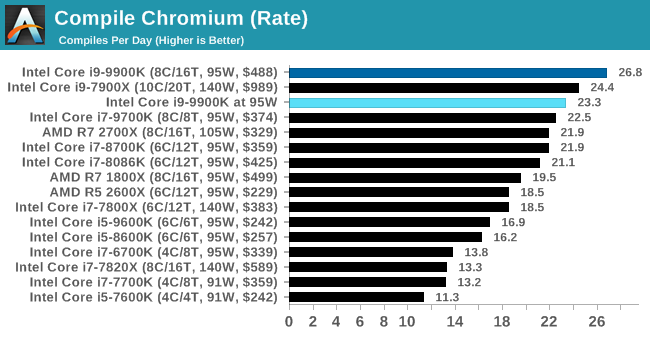
The 95W mode causes a small decrease in performance in our compile test, again moving it within a small margin to the Core i7-9700K.
3DMark Physics: In-Game Physics Compute
Alongside PCMark is 3DMark, Futuremark’s (UL’s) gaming test suite. Each gaming tests consists of one or two GPU heavy scenes, along with a physics test that is indicative of when the test was written and the platform it is aimed at. The main overriding tests, in order of complexity, are Ice Storm, Cloud Gate, Sky Diver, Fire Strike, and Time Spy.
Some of the subtests offer variants, such as Ice Storm Unlimited, which is aimed at mobile platforms with an off-screen rendering, or Fire Strike Ultra which is aimed at high-end 4K systems with lots of the added features turned on. Time Spy also currently has an AVX-512 mode (which we may be using in the future).
For our tests, we report in Bench the results from every physics test, but for the sake of the review we keep it to the most demanding of each scene: Cloud Gate, Sky Diver, Fire Strike Ultra, and Time Spy.
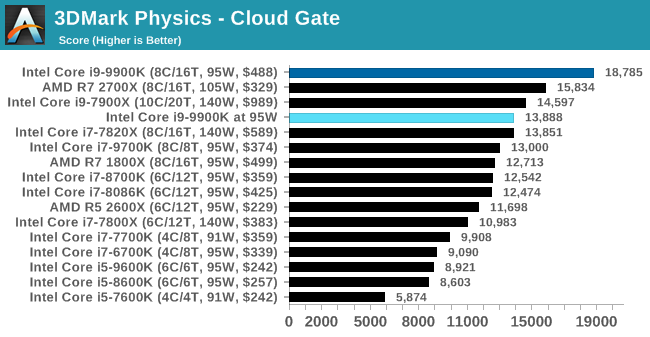


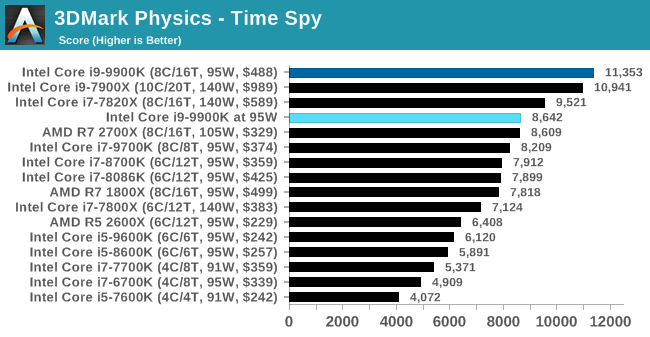
GeekBench4: Synthetics
A common tool for cross-platform testing between mobile, PC, and Mac, GeekBench 4 is an ultimate exercise in synthetic testing across a range of algorithms looking for peak throughput. Tests include encryption, compression, fast Fourier transform, memory operations, n-body physics, matrix operations, histogram manipulation, and HTML parsing.
I’m including this test due to popular demand, although the results do come across as overly synthetic, and a lot of users often put a lot of weight behind the test due to the fact that it is compiled across different platforms (although with different compilers).
We record the main subtest scores (Crypto, Integer, Floating Point, Memory) in our benchmark database, but for the review we post the overall single and multi-threaded results.
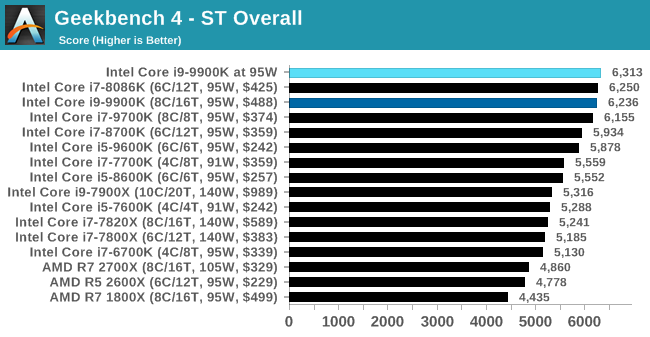











101 Comments
View All Comments
schujj07 - Thursday, November 29, 2018 - link
You are missing the entire point of the article. This is a follow-up to how Intel rates TDP for their CPUs. Intel's TDP is for the base clock only and this was to show what the performance would be if they had TDP meaning the absolute max power draw of the CPU. Right now the i9-9900k uses over 160W of power in its out-of-box configuration that most people use. If you buy a CPU cooler that is rated for say 125W thinking you will be covered since it is a "95W" CPU you will not be getting the performance that you are seeing in professional benchmarks. AMD on the other hand has their TDP being the max power draw of the CPU. Exception being the 2700X that hits like 110W in reviews I have seen. Therefore you buy a 125W cooler for the 2700X you will get the performance you are expecting.4800z - Thursday, November 29, 2018 - link
The 2700x can't go faster even if you gave it more power and a more expensive cooler. No one has been able to materially overclock the 2700x.Hul8 - Thursday, November 29, 2018 - link
It's not about OC, but the experience out of the box.Out of the box, AMD very closely follows TDP, going over by 5 - 10 W at the most.
Intel motherboard manufacturers ignore Intel guidelines and allow the CPU to boost ad infinitum (instead of the Intel spec 8 seconds). This means that *out of the box*, a CPU rated 95 W will require a 145 - 160 W cooler when running 100% on all cores, or it will throttle.
Hul8 - Thursday, November 29, 2018 - link
Obviously once you run a i9 9900K at 150 W, you will definitely get much better performance, but that is contingent on good cooling.Targon - Thursday, November 29, 2018 - link
And you won't get great cooling in a SFF machine.Alexvrb - Friday, November 30, 2018 - link
That's the main point. The reviews and benches all are testing it on "unlimited", which makes it look better than it actually IS when you're TDP-limited.A lesser issue is that when you're NOT TDP limited, it eats a crapton more power, runs hotter, and dumps more heat into your system than you were anticipating based on TDP.
The cake is a lie. I mean TDP.
HStewart - Thursday, November 29, 2018 - link
I would think that people that overclock a system, would understand that running at higher than base clock means that you need a more powerful power supply - plus they like have external GPU that uses a lot power and in a lot cases more than the CPU itself.Hul8 - Thursday, November 29, 2018 - link
Problem here is that it's not the user overclocking the system - it's the motherboard with default UEFI settings increasing Tau to (close to) infinity, thereby allowing the CPU to boost for hours.Beginners won't even be aware that they're not getting the most of their expensive CPU, since there is no way for them to know to anticipate 145 - 160 W of thermal dissipation.
Hul8 - Thursday, November 29, 2018 - link
ASUS is the only motherboard manufacturer whose Z390 boards can be configured to obey the TDP and even there you first need to enable XMP and then select "Intel" instead of "ASUS" in the prompt that appears. If you don't touch XMP (as many beginners are likely to), you'll run with grossly extended Tau out of the box.HStewart - Thursday, November 29, 2018 - link
I would expect if the motherboard company is making the settings higher than recommend from processor company - they should inform the customer they recommend larger power. This assumes I understand the entire motherboard settings of desktop machines lately - it been about slight over 10 years since I built a desktop machine and it was a Supermicro Dual Xeon